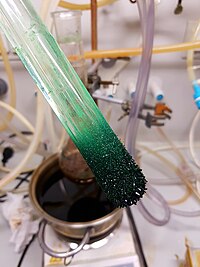Nickelocene
|
|
|||
 |
|||
| Names | |||
|---|---|---|---|
|
IUPAC name
nickelocene
|
|||
| Other names
Bis(cyclopentadienyl) nickel(II)
|
|||
| Identifiers | |||
| ChEBI | |||
| ECHA InfoCard | 100.013.672 | ||
|
PubChem CID
|
|||
| RTECS number | QR6500000 | ||
| Properties | |||
| C10H10Ni | |||
| Molar mass | 188.88 g/mol | ||
| Appearance | Green crystals | ||
| Density | 1.47 g/cm3 | ||
| Melting point | 171 to 173 °C (340 to 343 °F; 444 to 446 K) | ||
| insoluble | |||
| Structure | |||
| D5h, D5d | |||
| 0 D | |||
| Hazards | |||
|
EU classification (DSD)
|
|||
| R-phrases | R20/21/22, R42/43 | ||
| S-phrases | S22, S24, S36/37, S45 | ||
| NFPA 704 | |||
| Lethal dose or concentration (LD, LC): | |||
|
LD50 (median dose)
|
490 mg kg−1 (oral, rat) 600 mg kg−1 (oral, mouse) |
||
| Related compounds | |||
|
Related compounds
|
, FeCp2 | ||
|
Except where otherwise noted, data are given for materials in their standard state (at 25 °C [77 °F], 100 kPa).
|
|||
|
|
|||
| Infobox references | |||
Nickelocene is the organonickel compound with the formula Ni(η5-C5H5)2. Also known as bis(cyclopentadienyl)nickel or NiCp2, this bright green paramagnetic solid is of enduring academic interest, although it does not yet have any known practical applications.
Ni(C5H5)2 belongs to a group of organometallic compounds called metallocenes. Metallocenes usually adopt structures in which a metal ion is sandwiched between two parallel cyclopentadienyl (Cp) rings. In the solid-state, the molecule has D5hsymmetry, wherein the two rings are eclipsed.
The Ni center has a formal +2 charge, and the Cp rings are usually assigned as cyclopentadienyl anions (Cp−), related to cyclopentadiene by deprotonation. The structure is similar to ferrocene. In terms of its electronic structure, three pairs of d electrons on nickel are allocated to the three d orbitals involved in Ni–Cp bonding: dxy, dx2–y2, dz2. One of the two remaining d-electrons resides in each of the dyz and dxz orbitals, giving rise to the molecule's paramagnetism, as manifested in the unusually high field chemical shift observed in its 1H NMR spectrum. With 20 valence electrons, nickelocene has the highest electron count of the transition metal metallocenes. , Co(C5H5)2, with only 19 valence is, however, a stronger reducing agent, illustrating the fact that electron energy, not electron count determines redox potential.
Nickelocene was first prepared by E. O. Fischer in 1953, shortly after the discovery of ferrocene, the first metallocene compound. It has been prepared in a one-pot reaction, by deprotonating cyclopentadiene with ethylmagnesium bromide, and adding anhydrous nickel(II) acetylacetonate. A modern synthesis entails treatment of anhydrous sources of NiCl2 with sodium cyclopentadienyl:
...
Wikipedia



